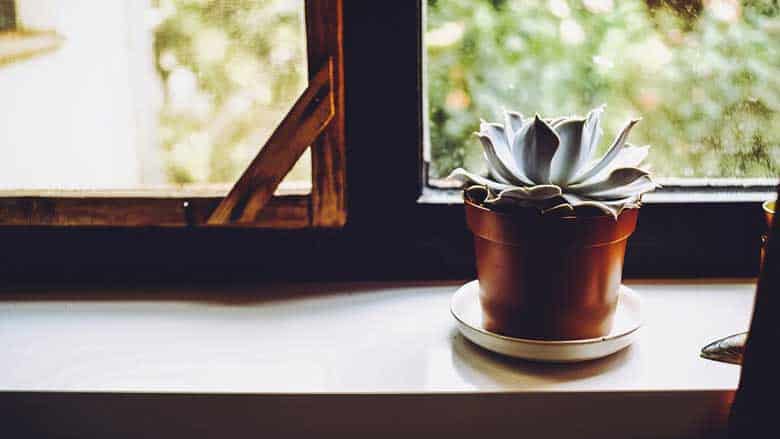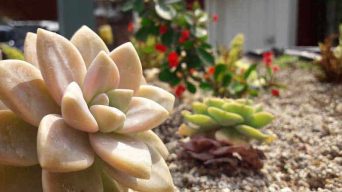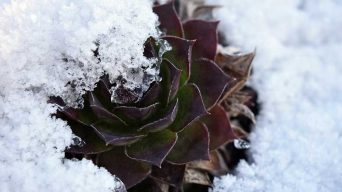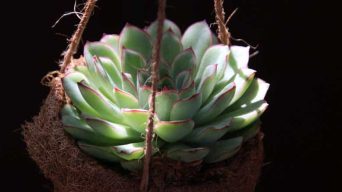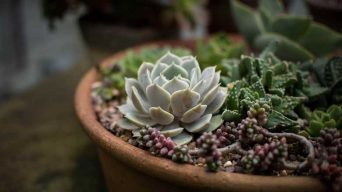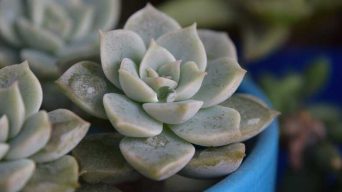Succulents are one of the most popular plants to grow indoors.
They come in various colors and sizes, from small cacti to large succulent plants with wide leaves.
While they require little care, there are still things you need to know how to do if you want your succulents to thrive indoors!
But how to care for indoor succulents?
This article will talk about how much light indoor succulents need, how often they need water, what type of soil is the best for them, and more.
How to Care For Succulents Indoors
Succulents are easy houseplants to take care of, so even if you don’t consider yourself a green-thumbed gardener, succulent plants can be perfect for you.
Since they require very little water and sunlight compared to other types of greenery, these super simple indoor houseplants continue to grow even when you forget to take care of them.
Below you will find everything you need to know about how to care for indoor succulents, from watering and sunlight requirements to pruning these indoor plants.
Light Requirements for Indoor Succulents
Indoor succulents require bright indirect light. Most mature indoor succulent plants need five to six hours of direct sunlight per day to grow and thrive indoors.
Some sunlight exposure is better than none, so you can place your plant near a window where it will get good indirect natural or artificial lighting for several hours a day.
If there are no windows in your home that receive bright light throughout the day, try using an artificial growing lamp instead during winter months when daylight is scarce.
Succulents prefer east or west-facing windows that receive bright light but avoid direct midday sunlight.
If the succulent leaves become twisted and deformed, it is telling you that they are getting too much sun exposure; move it to a shadier location instead of pulling out your hair over this problem!
Temperature and Humidity Requirements for Indoor Succulents
Indoor succulents need a temperature between 60 and 80 degrees, with low humidity.
Succulents can handle temperatures as high as 100 degrees if the air is dry. Temperatures below 40 or above 90 are not ideal for succulents indoors.
Humidity levels should be under 60% to prevent rot from occurring in the soil of your plants. However, some succulents can handle higher humidity levels.
When caring for indoor succulents, you should also avoid drafts since they are very sensitive to environmental changes.
It is important to place your plants away from windows, air vents, and fans.
Frequent temperature changes can cause the leaves of even hardy plants to turn brown and die.
How To Water Indoor Succulents
Succulent plants are very low maintenance, which is one of the reasons that they are so popular as houseplants.
However, just because succulents don’t need much care doesn’t mean you should neglect them!
The first thing to remember when caring for succulents indoors is that all plants require water to survive and remain healthy.
Succulents should be watered every one to two weeks, but the frequency of watering is dependent on a number of different factors.
The best way to tell if your succulents need water is to simply touch the soil. If it feels dry, then you should water them!
Succulents should be watered thoroughly until water runs out from their bottom holes or pots.
This can be done by watering your succulent over a sink or outside if the weather permits.
When watering indoor succulents, always use room temperature water as cold or hot water can cause the pores on their leaves to close up and lead to damage.
This means it is important not to let your plants sit in standing water after being watered either.
While succulents can handle a fair amount of neglect, they won’t recover if their roots are constantly sitting in water.
What Time of Day Should I Water My Succulents?
When caring for indoor succulents, it is important to water them at the appropriate time of day.
Succulent plants usually need to be watered in the morning or early evening when temperatures are cooler, and sunlight exposure is limited.
Watering your succulents near noon can lead to sunburn on their leaves, which will cause them to die.
Should You Mist Indoor Succulents?
Most succulents grow naturally in dry climates and don’t require misting.
Misting succulents can cause them harm by encouraging fungal growth and attracting pests.
If you live in a very dry climate, it is best to only water your succulents when necessary instead of misting their leaves for added humidity.
Succulents need infrequent but thorough watering to thrive, so misting them is usually unnecessary.
Best Potting Soil for Indoor Succulents
Succulent plants need well-draining soil that doesn’t retain too much moisture.
A good rule of thumb is to use a potting mix that drains quickly and provides just enough water for the plant without causing pooling or puddling at the base of the container.
Consider using specific succulent soil mixes designed to provide the proper balance of nutrients and water.
The best potting soil for succulents is a well-draining cactus potting mix, which may also be labeled as “succulent” or “cacti” potting soil.
The next best option would be a good quality standard bagged all-purpose garden potting mix with some added sand and perlite to improve drainage.
Avoid using mixtures of potting soil, peat moss, and vermiculite, as these can become waterlogged.
Potting Indoor Succulents
Planting indoor succulents is very easy. When planting succulents, make sure that the pot has drainage holes.
Succulent plant roots need to breathe and do not like stagnant water on their roots.
The best type of pots for succulents are those made out of terracotta, ceramic, or plastic.
Avoid planting succulents in pots made of metal because they will not breathe properly, and your plants may die due to rot.
When potting your succulents, make sure that you choose a pot size appropriate for the plant. The pot should leave a couple of inches of space on each side for the plant.
When you pot your succulents, make sure that the soil is well compacted and there are no air pockets along the sides or bottom of the container.
Succulents need to be planted at the same soil level they were in when you bought them.
Place a thin layer of fine gravel at the bottom of your pot before planting succulents to ensure proper drainage and add color contrast to your plantings.
You can also use decorative rocks or stones along with some charcoal for an interesting look!
Repotting Indoor Succulents
Succulent care can be easy if you know what to do. Many people struggle with repotting indoor succulents, but it doesn’t have to be.
Repotting is the process of moving your succulents into a larger pot, giving them fresh soil, and letting their roots breathe.
One of the easiest ways to ensure they stay healthy is repotting them every so often, though it depends on how quickly you want your succulent to grow.
They can get pretty stalky when left in their original pot too long and may need a bigger container than what they’re in.
Repotting an indoor succulent is quite easy.
You can use any container you’d like, but make sure to remove the old soil from your plant first before placing it in a new pot.
When repotting, use a new fresh soil mixture; this will ensure your succulent has the nutrients it needs to stay healthy.
It’s important not to water your indoor succulents after you’ve repotted them for at least one week.
This gives the roots time to heal and grow into their new soil mixture before you water it again.
Succulents are easy plants to care for, so don’t be afraid of repotting your succulents every now and then.
Fertilizing Indoor Succulents
Succulents don’t need a lot of fertilizing. They only require it once or twice a year during the growing season, which is spring and summer.
Some succulents don’t need any fertilizer because they are so slow-growing that you can go years without needing to feed them again.
If you do fertilize your succulents, use a diluted liquid fertilizer. Most succulents can be fertilized with a diluted 20-20-20 fertilizer at half strength.
When fertilizing your succulents, it’s best to apply the fertilizer to the soil instead of directly on top.
This is because any excess fertilizer that comes in contact with its leaves can cause damage to them.
When applying it to the soil, water it well afterward.
Remember to feed them less than you fertilize other plants because succulents can be sensitive.
Pruning Indoor Succulents
Indoor succulents need to be pruned when they start growing too tall.
Pruning will also help the plant stay fuller with more lush leaves since it will retain its energy in creating new growth rather than continue to elongate taller stems.
Pruning overgrown succulents can be done at any time, but it is often best to prune them after they have finished flowering so that the plant’s energy can be reallocated to creating new roots and leaves.
When pruning indoor succulents, you can cut off individual leaves or stems with sharp shears and a clean-cut (be sure to sterilize your cutting tools before use), or you could snip out an entire stem near where it connects with other branches using loppers.
If there are any dead or damaged leaves, those should be removed as well. The best time to prune succulents is when they have filled out and have a thick canopy of foliage – usually after the growing season has ended.
Remember that most indoor succulents will grow new stems from their leaf joints (or nodes) if these are cut off during pruning.
Succulent leaves should be trimmed off at a 45-degree angle to eliminate brown or dead areas and reduce too-tall stems.
If desired, you can keep your plant compact by cutting off the top third portion of its stem (but make sure you don’t remove all of it).
Common Problems With Indoor Succulents
Succulents are easy to care for, but some problems can occur.
The most common problem with succulents is overwatering.
Succulents do not need to be watered very often, and keeping them wet all the time will cause rot or mold in your plants. Make sure you only water every few days (or even less) when they are inside.
Another issue that can arise with succulents is sunburn.
This does not happen often, but if you place your plant in a window or right beside one and the leaves begin to look translucent and crunchy, it has gotten too much sunlight.
If this happens, try moving them to a shadier spot until they appear healthy again.
Common Diseases of Indoor Succulents
Succulents are not usually affected by diseases, but a few can occur.
Root Rot
Root rot is the most common disease affecting succulents and occurs when they sit in moist soil for too long.
If your succulent has been outside during the winter, it may have gotten root rot from being so cold all season.
Make sure you let them dry out before watering again.
Powdery Mildew
Another disease that can affect succulents is powdery mildew.
If your plant has small, white circles on the leaves, it may have a fungal infection and should be taken outside in a shady area to dry out.
You will need to remove all of the soil from around the roots with tweezers so there is no chance of reinfection.
Common Pests That Affect Indoor Succulents
Succulents are not usually affected by pests, but a few can be a problem.
Aphids
Aphids are tiny insects that like to suck the juices out of succulents.
They can be identified by their flat, pear-shaped body and two little tubes sticking up from the rear end.
These should be removed with tweezers or a cotton swab dipped in rubbing alcohol (sealing them in a plastic bag first), so the plant does not become reinfected.
Snails and Slugs
If you have slugs or snails outside your house, they may wander inside to look for moisture.
These can be removed by placing a little salt on them, then picking them up with tweezers or a paper towel, so there is no chance of the slime being left on the plant.
Mealybugs
Mealybugs are small bugs that look like white cotton.
They can be difficult to see until there is a large infestation and should be treated with insecticidal soap or oil.
You will need tweezers to remove them from the plants since they do not dissolve in water.
Preventing Problems With Indoor Succulents
The best way to prevent any potential problems with succulents is by placing them in indirect sunlight and watering them only when the soil has dried out.
It is better to water your succulents too little than too much, so you should only water them when the soil has completely dried out.
Succulents are drought-tolerant but do not want their roots sitting in wet soil for long periods. This can cause root rot and kill the plant.
Also, make sure you are placing your succulents in indirect sunlight. If the leaves begin to get translucent, it is getting too much light and should be moved away from any windows or bright areas.
To avoid pests or diseases on your succulents, ensure they are not sitting in any standing water and no moisture trapped against the leaves.
This will reduce the chance of mold, mildew, aphids, snails/slugs, and mealybugs.
5 Easy to Care For Indoor Succulents
Growing indoor succulents is a great way to add color and texture to your home.
Succulents are relatively low-maintenance plants that can be grown in conditions ranging from full sun to full shade and require very little water.
This list contains five types of succulents that work well as houseplants.
Take a look at this list of plants that are easy to care for.
Aloe Juvenna (Tiger Tooth Aloe)
The Aloe juvenna succulent has yellowish-green leaves with small teeth running along the edges.
This succulent does well in full sun to partial shade and likes to be watered when dry but will not tolerate standing water or overwatering very much.
Crassula Arborescens (Silver Dollar Plant)
The Crassula arborescens is a popular succulent with long, oval-shaped leaves covered in silver scales.
This plant does best with full sun or partial shade and can withstand dry conditions well.
Water only when the soil is completely dry to avoid root rot or fungal infections to keep this houseplant healthy.
Echeveria Elegans (Mexican Snowball)
The Echeveria elegans is a slow-growing succulent with rosettes covered in white hairs.
This plant requires regular watering and lots of sunlight to thrive, but keep it out of direct sunlight as this can cause the leaves to burn.
A great way to water this succulent is to soak it in a water sink for about 15 minutes every week or two.
Euphorbia Trigona (African Milk Tree)
The Euphorbia trigona succulent has green stems covered in thorns and magenta-red leaves.
This succulent does best with lots of sunlight but can survive in partial shade throughout the day.
Water this plant regularly, only when the soil is completely dry to avoid root rot or fungal infections.
Haworthia Cymbiformis (Cathedral Window)
The Haworthia cymbiformis plant has pale green, fleshy leaves with transparent tips.
This succulent does well with full sun to partial shade, but avoid direct sunlight as it can burn the leaves.
Water this plant regularly by allowing the soil to dry before watering again, and never let the roots of this houseplant sit in water, or they will begin to rot.
Final Thoughts
Succulent plants are probably one of the easiest types of houseplants, making them ideal for anyone who wants to add a bit more life into their home without having too much work on their hands when it comes to caring for them.
They’re beautiful and can last a long time, even years if properly taken care of.
Succulent plants are straightforward to care for and don’t need too much work on your part to keep them alive and healthy.
But one thing is for sure, whether you are taking care of outdoor succulents or growing them indoors, you will have a lot of fun caring for these plants.
Growing succulents indoors can be a fun and rewarding experience that you can continue to do as long as you want.
It’s easy, it doesn’t take much effort on your part, and the plants are beautiful!

